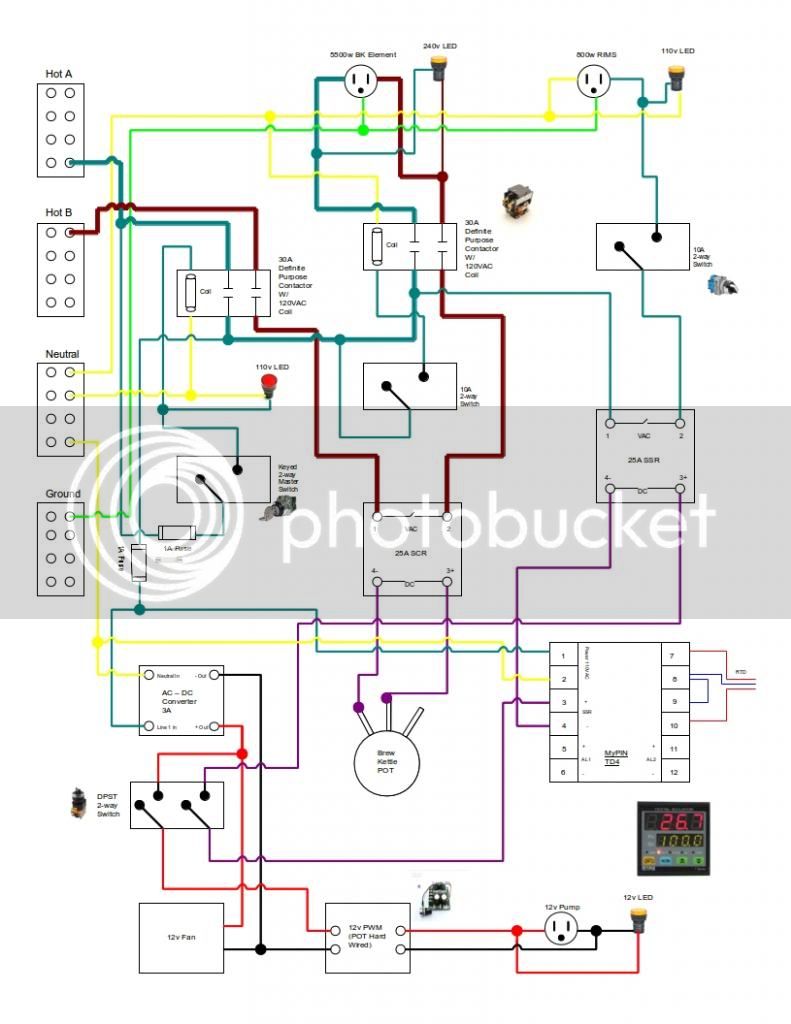Right now I have a PWM setup for my 5500W element installed in box. I also have an amp & volt meter and cooling fan in there. I have purchased some parts to build a small, cheap 800W RIMS tube. I would like to add a cheap PID (my pin td4), indicator lights, 2-way switch for the element, and maybe mount my PWM for my 12V pump inside the box also. I don't want an e-stop.
I have been looking around and so far I have come up with some parts based off of my limited knowledge:
PID: http://www.amazon.com/dp/B0087O6S2A/?tag=skimlinks_replacement-20
Switch: http://www.ebay.com/itm/310569446042?ssPageName=STRK:MEWNX:IT&_trksid=p3984.m1439.l2649
Contactor: http://www.ebay.com/sch/i.html?_sac...urpose Contactor&rt=nc&LH_FS=1&_udlo&_udhi=13
XLR3 Female Plug: http://www.ebay.com/itm/2x-3P-XLR-C...=US_Audio_Cables_Adapters&hash=item5d47e0c646
I will also be using switchcraft or another speakon type of power adapter for all of my power needs.
My issue is that I have a spa panel with only 3 wire heading into my box, so I have no usable neutral for my 120v 800W element, 12V fan or 12V pump. Maybe in the future I will have 4 wire setup, but not for a long time. Instead I figured I could run 240 and 120 separately into my box. I do this now in way, I have my 1500W element in my HLT running into a 120 (gfi) outlet while my 240 from the stove runs into my box.
Could I run a cable from 120 outlet to my box also and use that to power my ac-dc converter and 800W element? Any issues doing this? I am going to leave the HLT separate until I can afford another PID setup. I figured I would have to leave out the main power selector switch until I have 4-wire coming in. When that happens I will likely just re-wire the whole box. Eventually I want a 2 PID, 1 PWM, 1-2 12v pump system.
Anyway I hope I have been clear enough so you get the idea. Any diagrams, concerns or advice are more than welcome.
I have been looking around and so far I have come up with some parts based off of my limited knowledge:
PID: http://www.amazon.com/dp/B0087O6S2A/?tag=skimlinks_replacement-20
Switch: http://www.ebay.com/itm/310569446042?ssPageName=STRK:MEWNX:IT&_trksid=p3984.m1439.l2649
Contactor: http://www.ebay.com/sch/i.html?_sac...urpose Contactor&rt=nc&LH_FS=1&_udlo&_udhi=13
XLR3 Female Plug: http://www.ebay.com/itm/2x-3P-XLR-C...=US_Audio_Cables_Adapters&hash=item5d47e0c646
I will also be using switchcraft or another speakon type of power adapter for all of my power needs.
My issue is that I have a spa panel with only 3 wire heading into my box, so I have no usable neutral for my 120v 800W element, 12V fan or 12V pump. Maybe in the future I will have 4 wire setup, but not for a long time. Instead I figured I could run 240 and 120 separately into my box. I do this now in way, I have my 1500W element in my HLT running into a 120 (gfi) outlet while my 240 from the stove runs into my box.
Could I run a cable from 120 outlet to my box also and use that to power my ac-dc converter and 800W element? Any issues doing this? I am going to leave the HLT separate until I can afford another PID setup. I figured I would have to leave out the main power selector switch until I have 4-wire coming in. When that happens I will likely just re-wire the whole box. Eventually I want a 2 PID, 1 PWM, 1-2 12v pump system.
Anyway I hope I have been clear enough so you get the idea. Any diagrams, concerns or advice are more than welcome.
Last edited by a moderator:







